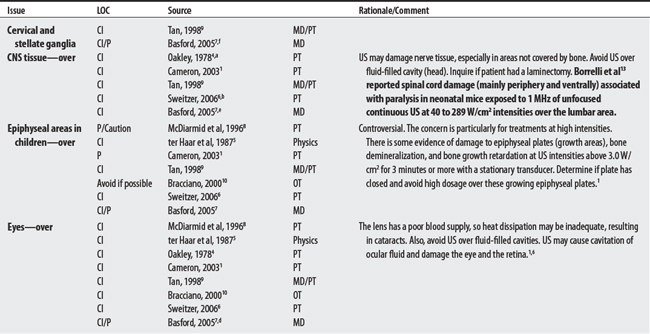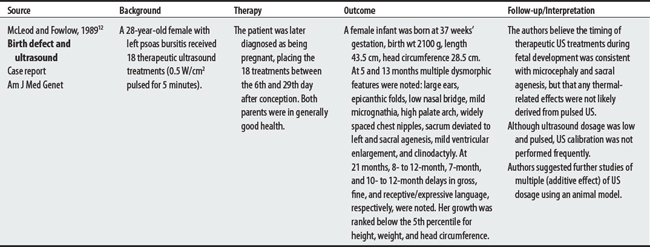Chapter 46 Sound Agents
OVERVIEW.
Therapeutic ultrasound is a physical agent that emits high frequency oscillations or sound waves (0.7 to 3.3 MHz frequency range) that penetrates tissue and produces deep heat. The clinical aim is to promote healing by softening scar tissue, increasing cell metabolism, and promoting nutrition. The agent has both a thermal and mechanical effect.1 Because therapeutic ultrasound produces heat, tissues need to be capable of dissipating heat via adequate blood circulation.
SUMMARY: CONTRAINDICATIONS AND PRECAUTIONS.
While not formally listed under contraindications, sources generally recommended the procedure of moving the sound head (i.e., avoid stationary transducers) to avoid increasing the risk of hot spots, unstable cavitation, blood cell stasis, or blood vessel damage to the endothelial cells. Pain from a stationary technique may suggest periosteal heating. In an in vivo 1974 study, Dyson2 describes blood cell stasis (temporary blood flow arrest) and endothelial damage (permanent) in the blood vessels of a chick embryo treated with US using a stationary technique (minimum intensity <0.5 W/cm2; 3 MHz).2
OTHER ISSUES.
In a case series, Gnatz3 reported transient radicular symptoms in 36-year-old and 37-year-old females with lumbar disc herniations a few minutes following US treatment to lumbar paraspinals at 1.5-1.75 W/cm2. The incidences were postulated to be due to heat-induced edema accumulation within a confined space.
Note: Several sources incorporates general thermotherapy concerns into their US guidelines.
A00-B99 CERTAIN INFECTIONS AND PARASITIC DISEASES
D50-D89 DISEASES OF BLOOD AND BLOOD-FORMING ORGANS, AND CERTAIN DISORDERS
E00-E90 ENDOCRINE, NUTRITIONAL, AND METABOLIC DISEASES
F00-F99 MENTAL AND BEHAVIORAL DISORDERS
G00-G99 DISEASES OF THE NERVOUS SYSTEM
I00-I99 DISEASES OF THE CIRCULATORY SYSTEM
L00-L99 DISEASES OF THE SKIN AND SUBCUTANEOUS TISSUE
M00-M99 DISEASES OF THE MUSCULOSKELETAL SYSTEM AND CONNECTIVE TISSUE
O00-O99 PREGNANCY, CHILDBIRTH, AND PUERPERIUM
S00-T98 INJURY, POISONING, AND CERTAIN OTHER CONSEQUENCES OF EXTERNAL CAUSES
1 Cameron MH. Physical agents in rehabilitation: from research to practice. St. Louis: Saunders, 2003.
2 Dyson M, Pond JB, Woodward B, Broadbent J. The production of blood cell stasis and endothelial damage in the blood vessels of chick embryos treated with ultrasound in a stationary wave field. Ultrasound Med Biol. 1974;63:133-138.
3 Gnatz SM. Increased radicular pain due to therapeutic ultrasound applied to the back. Arch Phys Med Rehabil. 1989;70(6):493-494.
4 Oakley EM. Dangers and contraindications of therapeutic ultrasound. Physiotherapy. 1978;64:173-174.
5 ter Haar G, Dyson M, Oakley EM. The use of ultrasound by physiotherapists in Britain, 1985. Ultrasound Med Biol. 1987;13(10):659-663.
6 Sweitzer RW. Ultrasound. In: Hecox B, Mehreteab TA, Weisberg J, editors. Integrating physical agents in rehabilitation. Upper Saddle River (NJ): Pearson Prentice Hall, 2006.
7 Basford JR. Therapeutic physical agents. Delisa JA, editor. Physical medicine and rehabilitation: principles and practices, ed 4, vol 1. Philadelphia: Lippincott Williams & Wilkins, 2005.
8 McDiarmid T, Ziskin MC, Michlovitz SL. Therapeutic ultrasound. In Michlovitz SL, editor: Thermal agents in rehabilitation, ed 3, Philadelphia: F.A. Davis, 1996.
9 Tan JC. Practical manual of physical medicine and rehabilitation: diagnostics, therapeutics, and basic problems. St. Louis: Mosby, 1998.
10 Bracciano AG. Physical agent modalities: theory and application for the occupational therapist. Thorofare (NJ): Slack, 2000.
11 Sicard-Rosenbaum L, Lord D, Danoff JV, et al. Effects of continuous therapeutic ultrasound on growth and metastasis of subcutaneous murine tumors. Phys Ther. 1995;75:3-11.
12 McLeod DR, Fowlow SB. Multiple malformations and exposure to therapeutic ultrasound during organogenesis. Am J Med Genet. 1989;34(3):317-319.
13 Borrelli MJ, Frizzell LA, Dunn F. Ultrasonically induced morphological changes in the mammalian neonatal spinal cord. Ultrasound Med Biol. 1986;12:285-295.
46.2 Phonophoresis
Phonophoresis uses sound energy (i.e., ultrasound) to introduce molecules (not ions) into the body.1 The overall concern is patient sensitivity to the substances (molecules) used during phonophoresis. Note: Other ultrasound concerns probably also apply for this therapy.





























